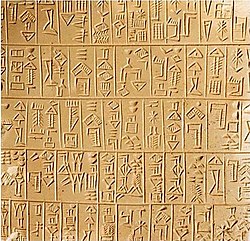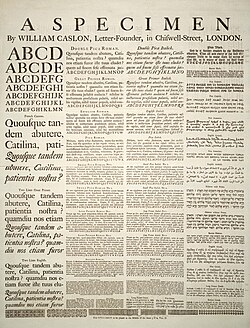CD of old
Since prehistoric times, significant changes in communication technologies (media and appropriate inscription tools) have evolved in tandem with shifts in political and economic systems, and by extension, systems of power. Communication can range from very subtle processes of exchange, to full conversations and mass communication. Human communication was revolutionized with theorigin of speech approximately 500,000 years ago. Symbols were developed about 30,000 years ago. The imperfection of speech, which nonetheless allowed easier dissemination of ideas and stimulated inventions, eventually resulted in the creation of new forms of communications, improving both the range at which people could communicate and the longevity of the information. All of those inventions were based on the key concept of the symbol.
The oldest known symbols created for the purpose of communication were cave paintings, a form of rock art, dating to theUpper Paleolithic age. The oldest known cave painting is located within Chauvet Cave, dated to around 30,000 BC.[1] These paintings contained increasing amounts of information: people may have created the first calendar as far back as 15,000 years ago.[2] The connection between drawing and writing is further shown by linguistics: in Ancient Egyptand Ancient Greece the concepts and words of drawing and writing were one and the same (Egyptian: 's-sh', Greek: 'graphein').[3]
Petroglyphs
The next advancement in the history of communications came with the production ofpetroglyphs, carvings into a rock surface. It took about 20,000 years for homo sapiens to move from the first cave paintings to the first petroglyphs, which are dated to around 10,000BC.[4]
It is possible that humans of that time used some other forms of communication, often for mnemonic purposes - specially arranged stones, symbols carved in wood or earth,quipu-like ropes, tattoos, but little other than the most durable carved stones has survived to modern times and we can only speculate about their existence based on our observation of still existing 'hunter-gatherer' cultures such as those of Africa or Oceania.[5]÷
Pictograms
A pictogram (pictograph) is a symbolrepresenting a concept, object, activity, place or event by illustration. Pictography is a form of proto-writing whereby ideas are transmitted through drawing. Pictographs were the next step in the evolution of communication: the most important difference between petroglyphs and pictograms is that petroglyphs are simply showing an event, but pictograms are telling a story about the event, thus they can for example be orderedchronologically.
Pictograms were used by various ancientcultures all over the world since around 9000 BC, when tokens marked with simple pictures began to be used to label basic farm produce, and become increasingly popular around 6000-5000 BC.
They were the basis of cuneiform [6] andhieroglyphs, and began to develop intologographic writing systems around 5000 BC.
Ideograms

The beginning of the Lord's Prayer in Míkmaq hieroglyphic writing. The text reads Nujjinen wásóq – "Our father / in heaven"
Pictograms, in turn, evolved into ideograms, graphical symbols that represent an idea. Their ancestors, the pictograms, could represent only something resembling their form: therefore a pictogram of a circle could represent a sun, but not concepts like 'heat', 'light', 'day' or 'Great God of the Sun'. Ideograms, on the other hand, could convey more abstract concepts, so that for example an ideogram of two sticks can mean not only 'legs' but also a verb 'to walk'.
Because some ideas are universal, many different cultures developed similar ideograms. For example, an eye with a tear means 'sadness' in Native Americanideograms in California, as it does for theAztecs, the early Chinese and theEgyptians.[citation needed]
Ideograms were precursors of logographic writing systems such as Egyptian hieroglyphsand Chinese characters.[citation needed]
Examples of ideographical proto-writing systems, thought not to contain language-specific information, include the Vinca script(see also Tărtăria tablets) and the early Indus script.[citation needed] In both cases there are claims of decipherment of linguistic content, without wide acceptance.[citation needed]
Writing

26th century BC Sumerian cuneiform scriptin Sumerian language, listing gifts to the high priestess of Adab on the occasion of her election. One of the earliest examples of human writing.
The oldest-known forms of writing were primarily logographic in nature, based onpictographic and ideographic elements. Most writing systems can be broadly divided into three categories: logographic, syllabic andalphabetic (or segmental); however, all three may be found in any given writing system in varying proportions, often making it difficult to categorise a system uniquely.
The invention of the first writing systems is roughly contemporary in with the beginning of the Bronze Age in the late Neolithic of the late 4000 BC. The first writing system is generally believed to have been invented in pre-historicSumer and developed by the late 3000's BCinto cuneiform. Egyptian hieroglyphs, and the undeciphered Proto-Elamite writing system and Indus Valley script also date to this era, though a few scholars have questioned theIndus Valley script's status as a writing system.
The original Sumerian writing system was derived from a system of clay tokens used to represent commodities. By the end of the 4th millennium BC, this had evolved into a method of keeping accounts, using a round-shapedstylus impressed into soft clay at different angles for recording numbers. This was gradually augmented with pictographic writing using a sharp stylus to indicate what was being counted. Round-stylus and sharp-stylus writing was gradually replaced about 2700-2000 BC by writing using a wedge-shaped stylus (hence the term cuneiform), at first only for logograms, but developed to include phonetic elements by the 2800 BC. About 2600 BC cuneiform began to represent syllables of spoken Sumerian language.
Finally, cuneiform writing became a general purpose writing system for logograms,syllables, and numbers. By the 26th century BC, this script had been adapted to another Mesopotamian language, Akkadian, and from there to others such as Hurrian, and Hittite. Scripts similar in appearance to this writing system include those for Ugaritic and Old Persian.
The Chinese script may have originated independently of the Middle Eastern scripts, around the 16th century BC (early Shang Dynasty), out of a late neolithic Chinese system of proto-writing dating back to c. 6000 BC. The pre-Columbian writing systems of theAmericas, including Olmec and Mayan, are also generally believed to have had independent origins.
Alphabet

A Specimen of typeset fonts and languages, by William Caslon, letter founder; from the 1728 Cyclopaedia.
The first pure alphabets (properly, "abjads", mapping single symbols to single phonemes, but not necessarily each phoneme to a symbol) emerged around 2000 BC in Ancient Egypt, but by then alphabetic principles had already been incorporated into Egyptian hieroglyphs for a millennium (see Middle Bronze Age alphabets).
By 2700 BC Egyptian writing had a set of some 22 hieroglyphs to represent syllables that begin with a single consonant of their language, plus a vowel (or no vowel) to be supplied by the native speaker. These glyphs were used as pronunciation guides forlogograms, to write grammatical inflections, and, later, to transcribe loan words and foreign names.
However, although seemingly alphabetic in nature, the original Egyptian uniliterals were not a system and were never used by themselves to encode Egyptian speech. In theMiddle Bronze Age an apparently "alphabetic" system is thought by some to have been developed in central Egypt around 1700 BC for or by Semitic workers, but we cannot read these early writings and their exact nature remains open to interpretation.
Over the next five centuries this Semitic "alphabet" (really a syllabary like Phoenician writing) seems to have spread north. All subsequent alphabets around the world[citation needed] with the sole exception of Korean Hangul have either descended from it, or been inspired by one of its descendants.
History of telecommunication
The history of telecommunication - thetransmission of signals over a distance for the purpose of communication - began thousands of years ago with the use of smoke signals and drums in Africa, America and parts of Asia. In the 1790s the first fixedsemaphore systems emerged in Europehowever it was not until the 1830s thatelectrical [telecommunication] systems started to appear.


Comments
Post a Comment